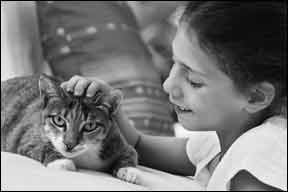Kids and pets are like peanut butter and jelly — it’s hard to imagine one without the other. They can quickly become the best of friends, playing for hours on end. A child’s best animal friends seem to know to be extra gentle with him, and they are often endlessly patient — calmly swallowing their pride and allowing themselves to be dressed in doll’s clothes, take a bubble bath or just be hauled around on the child’s whim. As such, the attachments between children and their pets can be very real and very strong, making it especially difficult when the pet dies. And, while we don’t usually like to think about death, it is a part of life. Fortunately, there are several simple ways a parent can help a child understand and work through the grieving process.

288
According to Robin Hamlisch, a licensed social worker and counselor in Cornell University’s Office of Student and Academic Services and Director of the Cornell Companions program in the College of Veterinary Medicine, “A pet dying is often the first experience a child has with death, so it is important to encourage children to talk about whatever it is they are feeling: sadness, confusion or fear. And respect the child’s feelings — all of them — as this is a very sensitive time for them.” It is also important to be honest about what happened to begin with: “Fluffy died because he was really sick.”
Ms. Hamlisch explains that the terms “put to sleep” or “went away” can be confusing and may frighten children into thinking that if they go to sleep, they might not come back either. Very often, parents are also experiencing their own grief: “It’s good for the adult to share their feelings, as well,” says Ms. Hamlisch, provided that they are presented in a way that’s appropriate for a child’s age.
Soothing Suggestions. There are several practical ways that a parent can help a child grieve and express new feelings.
Memorialization of the pet. Activities or projects that help children realize that they don’t have to “forget” their pet, but can remember and celebrate the pet’s life, can be very beneficial. A few examples, according to Ms. Hamlisch, are putting together a collage of pictures that you’ve taken over the years of the pet, painting a rock with the animal’s name to put outside under a tree or drawing pictures of the pet.
Taking time to talk about the pet. Talking with a child about a lost pet allows the child to express feelings and ask questions. Ms. Hamlisch advises adults to be honest — even if they don’t know the answer to a question. The grieving process is intricate and different for everyone, and there is often no perfect answer.
Seeking professional counseling help. If a child seems preoccupied or has changes in mood or behavior that persist for a long time, Ms. Hamlisch recommends speaking with a professional counselor who specializes in grief work.
Children’s friendships with their pets can add so much richness to their lives and character; helping them work through the grieving process will not only help them understand what happened, but will also help them begin to understand how death is a part of life.
And, if they learn to cope appropriately, they will begin to see that the grieving process can be an opportunity to celebrate the love and friendship they shared with a very special individual — two-legged or four-legged.


